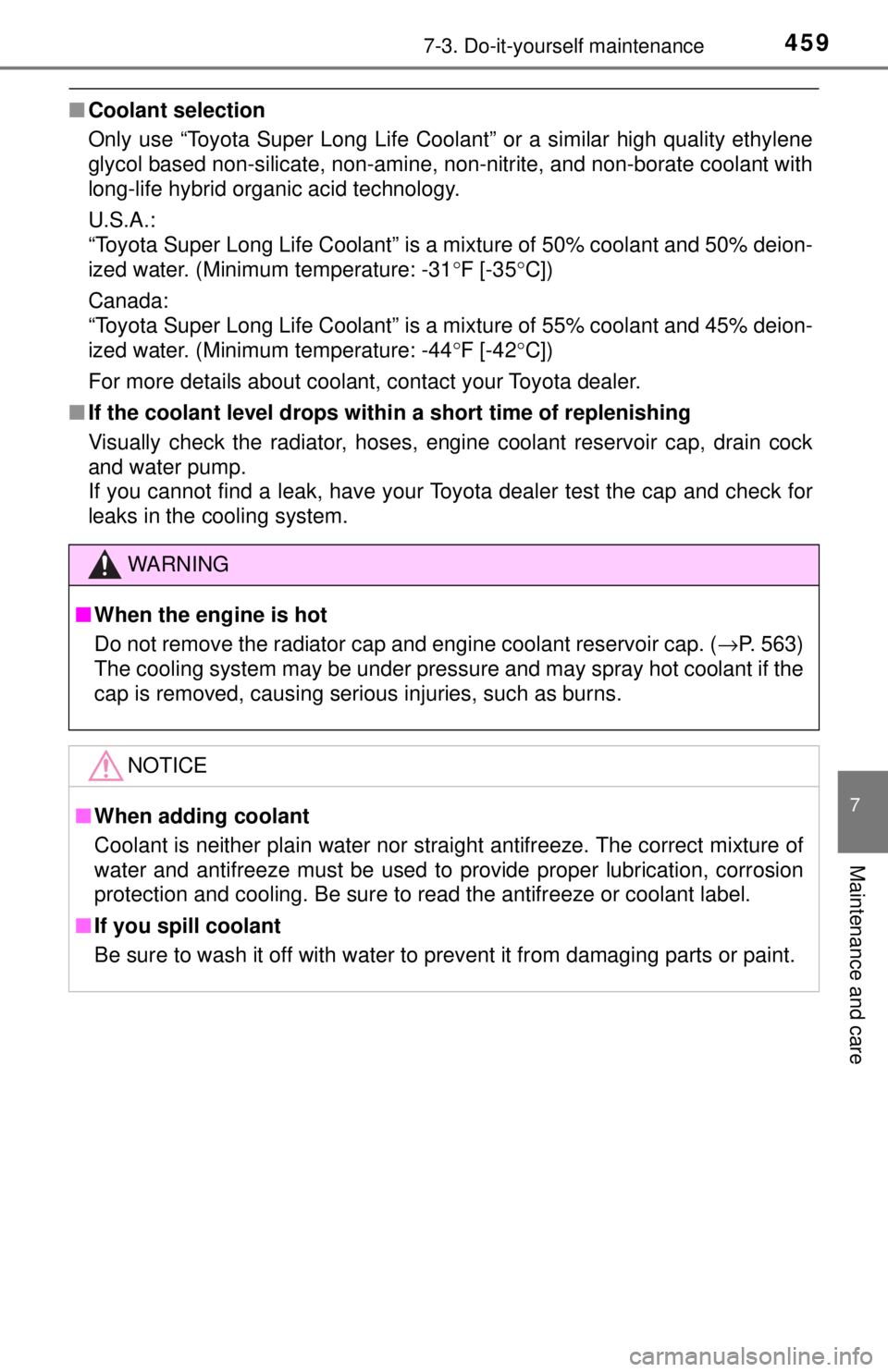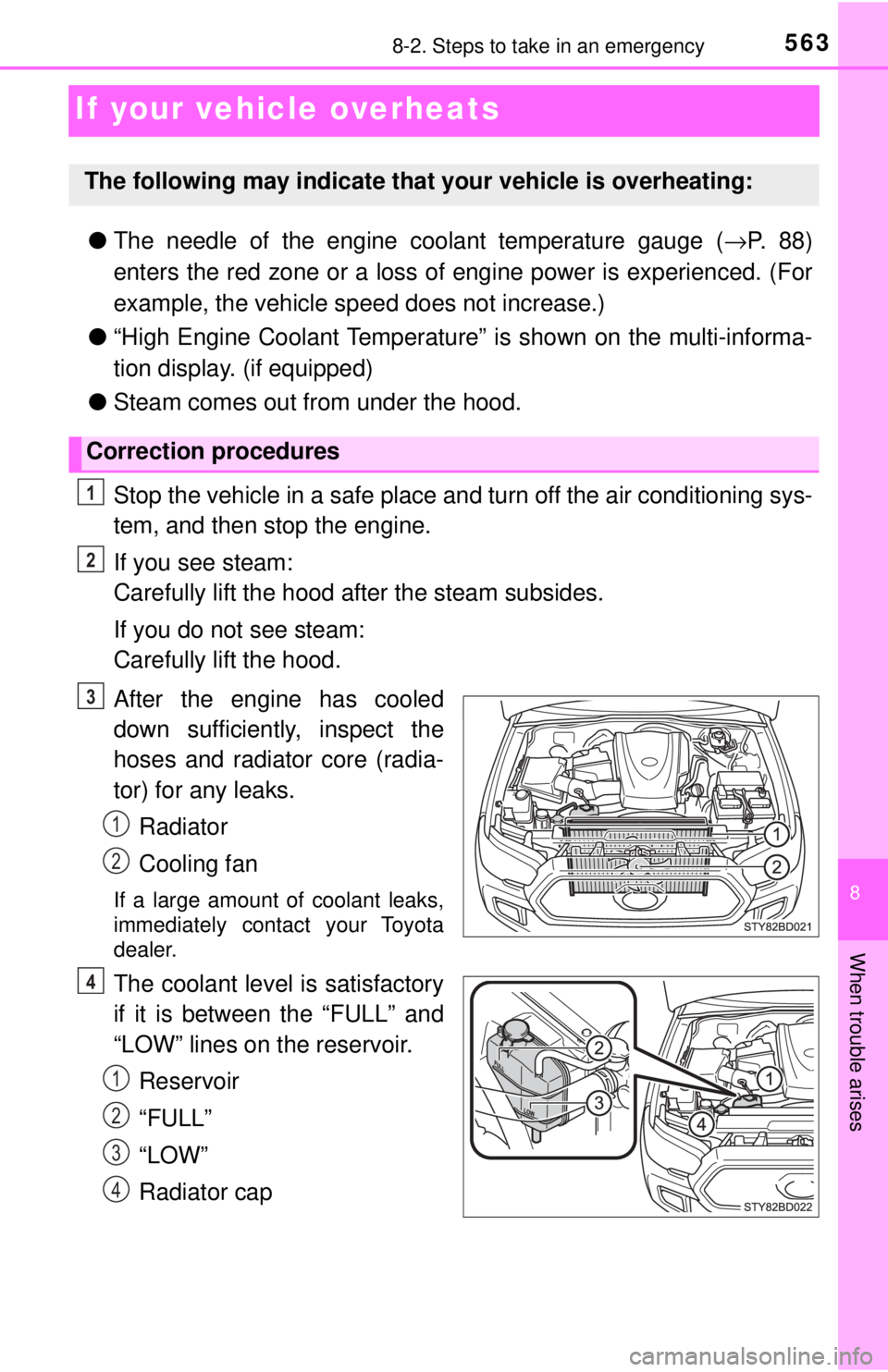Page 454 of 640
4547-3. Do-it-yourself maintenance
Engine compartment
2TR-FE engine
Washer fluid tank (→P. 465)
Radiator cap
Engine coolant reservoir (→ P. 458)
Engine oil filler cap ( →P. 457)
Power steering fluid reservoir (→ P. 461) Engine oil level dipstick
(→ P. 456)
Brake fluid reservoir (→ P. 460)
Fuse box ( →P. 488)
Battery (→ P. 463)
Condenser ( →P. 460)
Radiator ( →P. 460)1
2
3
4
5
6
7
8
9
10
11
Page 455 of 640
4557-3. Do-it-yourself maintenance
7
Maintenance and care
2GR-FKS engine
Washer fluid tank (→P. 465)
Power steering fluid reservoir (→ P. 461)
Radiator cap
Engine oil level dipstick (→ P. 456)
Engine coolant reservoir (→ P. 458) Engine oil filler cap (
→P. 457)
Brake fluid reservoir (→ P. 460)
Fuse box ( →P. 488)
Battery (→ P. 463)
Condenser ( →P. 460)
Radiator ( →P. 460)1
2
3
4
5
6
7
8
9
10
11
Page 459 of 640

4597-3. Do-it-yourself maintenance
7
Maintenance and care
■Coolant selection
Only use “Toyota Super Long Life Coolant” or a similar high quality ethylene
glycol based non-silicate, non-amine, non-nitrite, and non-borate coolant with
long-life hybrid organic acid technology.
U.S.A.:
“Toyota Super Long Life Coolant” is a mixture of 50% coolant and 50% deion-
ized water. (Minimum temperature: -31 °F [-35 °C])
Canada:
“Toyota Super Long Life Coolant” is a mixture of 55% coolant and 45% deion-
ized water. (Minimum temperature: -44 °F [-42 °C])
For more details about coolant, contact your Toyota dealer.
■ If the coolant level drops within a short time of replenishing
Visually check the radiator, hoses, engine coolant reservoir cap, drain cock
and water pump.
If you cannot find a leak, have your Toyota dealer test the cap and check for
leaks in the cooling system.
WARNING
■When the engine is hot
Do not remove the radiator cap and engine coolant reservoir cap. ( →P. 563)
The cooling system may be under pressure and may spray hot coolant if the
cap is removed, causing serious injuries, such as burns.
NOTICE
■ When adding coolant
Coolant is neither plain water nor stra ight antifreeze. The correct mixture of
water and antifreeze must be used to provide proper lubrication, corrosion
protection and cooling. Be sure to read the antifreeze or coolant label.
■ If you spill coolant
Be sure to wash it off with water to prevent it from damaging parts or paint.
Page 460 of 640
4607-3. Do-it-yourself maintenance
Check the radiator and condenser and clear away any foreign objects.
If either of the above parts is ex tremely dirty or you are not sure of
their condition, have yo ur vehicle inspected by your Toyota dealer.
■Checking fluid level
The brake fluid level should be between the “MAX” and “MIN” lines
on the tank.
“MAX” line
“MIN” line
■Adding fluid
Make sure to check the fluid ty pe and prepare the necessary item.
Ty p e B o n l y
Turn the engine off.
Depress the brake pedal 20 times or more.
Remove the reservoir cap.
Add newly opened brake fluid up to the “MAX” line.
Radiator and condenser
WARNING
■When the engine is hot
Do not touch the radiator or condenser as they may be hot and cause seri\
-
ous injuries, such as burns.
Brake fluid
Ty p e AType B
1
2
Fluid type FMVSS No.116 DOT 3 or SAE J1703 brake fluid
Items Clean funnel
1
2
3
4
Page 563 of 640

563
8
When trouble arises
8-2. Steps to take in an emergency
If your vehicle overheats
●The needle of the engine coolant temperature gauge ( →P. 8 8 )
enters the red zone or a loss of engine power is experienced. (For
example, the vehicle sp eed does not increase.)
● “High Engine Coolant Temperature” is shown on the multi-informa-
tion display. (if equipped)
● Steam comes out from under the hood.
Stop the vehicle in a safe place and turn off the air conditioning sys-
tem, and then stop the engine.
If you see steam:
Carefully lift the hood after the steam subsides.
If you do not see steam:
Carefully lift the hood.
After the engine has cooled
down sufficient ly, inspect the
hoses and radiator core (radia-
tor) for any leaks.
Radiator
Cooling fan
If a large amount of coolant leaks,
immediately contact your Toyota
dealer.
The coolant level is satisfactory
if it is between the “FULL” and
“LOW” lines on the reservoir.Reservoir
“FULL”
“LOW”
Radiator cap
The following may indicate that your vehicle is overheating:
Correction procedures
1
2
3
1
2
4
1
2
3
4
Page 564 of 640

5648-2. Steps to take in an emergency
Add coolant if necessary.
Water can be used in an emer-
gency if coolant is unavailable.
Start the engine to check that the radiator cooling fan operates and
to check for coolant leaks from the radiator or hoses.
If the fan is not operating:
Stop the engine immediately and contact your Toyota dealer.
If the fan is operating:
Have the vehicle in spected at the nearest Toyota dealer.
5
WARNING
■When inspecting under the hood of your vehicle
Observe the following precautions.
Failure to do so may result in serious injury such as burns.
● If steam is seen coming from under the hood, do not open the hood until
the steam has subsided. The engine compartment may be very hot.
● Keep hands and clothing away from the fans, etc., while the engine is run-
ning.
● Do not loosen the radiator cap and the coolant reservoir cap while the
engine and radiator are hot.
High temperature steam or coolant could spray out.
NOTICE
■When adding engine coolant
Add coolant slowly after the engine has cooled down sufficiently. Adding
cool coolant to a hot engine too quickly can cause damage to the engine.
■ To prevent damage to the cooling system
Observe the following precautions:
● Avoid contaminating the coolant with foreign matter (such as sand or dust,
etc.).
● Do not use any coolant additives.
6
7
Page 634 of 640

634Alphabetical index
Parking assist sensors (intuitive parking assist) ....... 223
Parking brake ........................... 205 Operation .............................. 205
Parking brake engaged
warning buzzer ................... 516
Parking brake engaged
warning message ............... 529
Parking lights ........................... 206 Light switch ........................... 206
Replacing light bulbs..... 496, 501
Wattage ................................ 580
Personal lights ......................... 390
Wattage ................................ 580
Power back window ................ 149
Power mode switch ................. 198
Power outlets ................... 412, 413
Power steering fluid ................ 461
Power windows........................ 145 Jam protection function......... 146
Operation .............................. 145
Power back window switch ................................. 149
Window lock switch............... 145 Radiator .................................... 460
Radio
*...................................... 302
Rear differential lock system ........................... 253
Rear seat Adjustment precautions ........ 133
Child seats/child restraint system installation ................ 55
Cleaning ............................... 441
Folding down ........................ 131
Head restraints ..................... 134
Raising the bottom cushion ............................... 131
Rear side marker lights........... 206 Light switch ........................... 206
Replacing light bulbs ............ 499
Wattage ................................ 580
Rear step bumper .................... 120
Rear turn signal lights ............ 204 Replacing light bulbs ............ 499
Turn signal lever ................... 204
Wattage ................................ 580
Rear view mirror Inside rear view mirror .......... 140
Outside rear view mirrors ..... 143
Rear view monitor system ...... 229
Refueling .................................. 214 Capacity................................ 572
Fuel types ............................. 572
Opening the fuel tank cap..... 216
PR